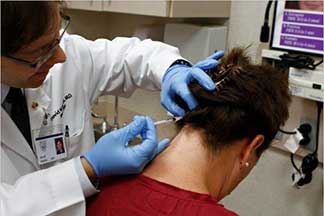Botox Injections
Botox belongs to a group of drugs known as Botulinum Toxin. It is a muscle relaxant that has been shown to relieve muscle related pain, and improve range of motion. Nearly 1 million patients worldwide have experienced pain relief from Botox.
Botox injections are typically indicated for:
- Muscle pain arising from chronic muscle spasm
- Neck pain in cervical dystonia
- Migraine Headaches
- Nerve disorders resulting in blepharospasm
- Myofascial pain
Botox works by blocking the release of a substance called acetylcholine from the junction between a nerve and muscle. Normally, acetylcholine binds to its receptor at this junction and causes a muscle contraction. When Botox is injected to an area of chronic muscle spasm, acetylcholine is blocked, allowing the muscles to relax.
Botox is administered directly to the desired site through an injection. The onset of relief occurs in about a week and typically lasts 3 months. After three months, the muscles may once again become overactive, so four injections per year are recommended. Long-term therapy with Botox has been found to be very effective. Additionally, physical therapy can maximize the effects of Botox, helping to maintain flexibility and reduce the recurrence of spasms, so that Botox injections will no longer be needed.
Botox injections have also been proven to be effective in treating migraine and tension type headaches. (Otolaryngol Head Neck Surg 2000;123:669-76.) Patients with migraine headaches who experience headaches 16 or more days a month and describe their headaches as “squeezing” or ” crushing”, report a significant decrease in their headache pain by at least 50%. (Pain. 2006 December 5; 125(3): 286-295.)
Patients report very few side effects from Botox Injections for muscle pain. Some minor side effects a day or two of swelling, tenderness and localized pain at the injection site. In a small percentage of patients, flu-like symptoms may occur for a few days after the injection. Additionally, because Botox causes muscle relaxation, some patients may temporarily feel weak in the treated muscles. Extremely rarely, there have been deaths associated with Botox A most often from a respiratory cause in children who have received large doses of Botox for muscle spasticity.
Reimbursement assistance for those whose insurance does not cover it, or are otherwise unable to afford BOTOX can be found at https://www.botoxreimbursement.us. Or call 1-800-44-BOTOX, option 6. The form you will be required to complete can be downloaded here.




